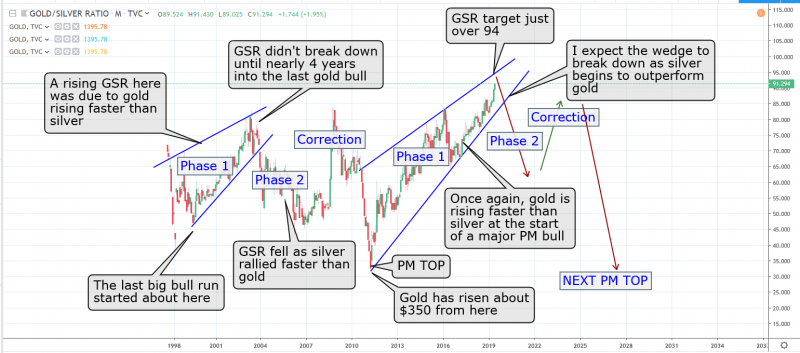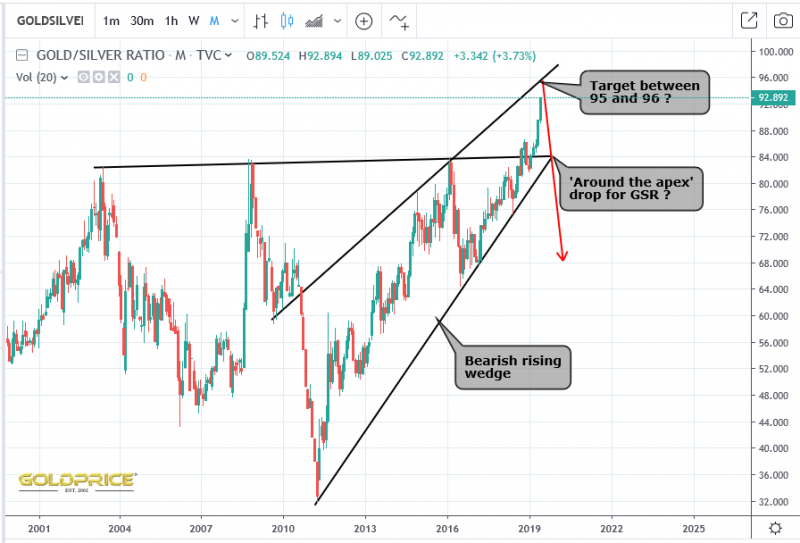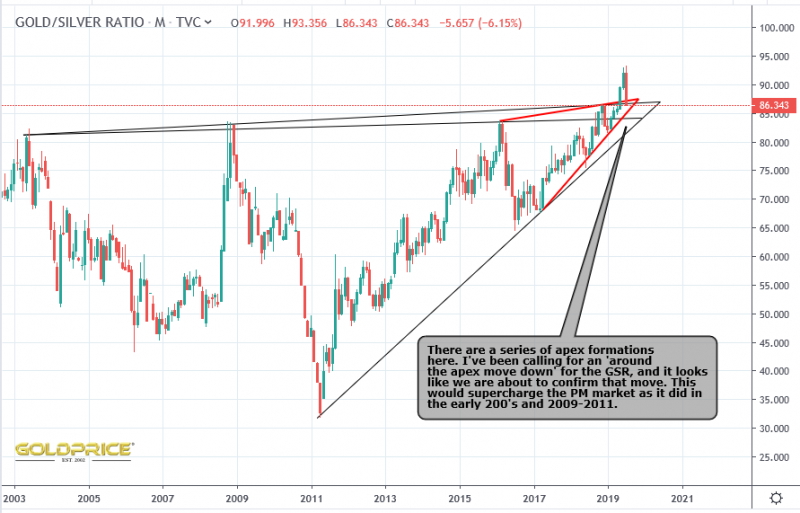Gold/Silver Ratio
I posted this last month…
I can’t take the credit for the use of ‘around the apex’ moves. Graddhy (formerly a member here, and now to be found on Twitter), has been right, time after time with these. I’ve been studying them carefully and come to some clear, and probably quite obvious conclusions.
- An apex forms at the culmination of a pattern with decreasing price movement
- The resulting triangle or wedge can be level, or tilted up or down (you can read about them on stockcharts etc)
- The key point for me – If they form at a historic market high and break upwards, you can pretty much guarantee a violent ‘around the apex’ move down. The opposite is of course true at historic market lows.
- The GSR is at a historic high, so it was always 95% likely to reverse down to pass through the apex and provide very, very strong evidence that we have a developing PM bull market on our hands
So, finally, here’s the chart updated with todays data…
I’m going to refrain from declaring this a done deal until GSR passes through the lower black line (somewhere near 80). A lifetime of experience teaches you that very unlikely things do sometimes happen for unforeseen reasons. However, the odds are very strongly in favour of a crashing GSR and energised PM market, with silver and silver miners surging.




Thank you, again.
Once more I seem to have the pleasant opportunity of re-learning. I don’t have the reference at hand, but I’m pretty sure I remember having learned, either from Edwards and Magee or from Jack Schwager that triangle-like patterns are often most powerful or reliable when they aren’t complete–in other words when the breakouts occur well before the apex. Perhaps I read wrong or remembered wrong. Rethinking time here.
Or perhaps the markets have changed. Maybe it used to be that powerful moves often started well before the apex but now they don’t. Don’t know.
That has been said Karl, but I think it applies to standard apex break outs or breakdowns, where you’d expect the move well before the apex. This is a slightly different case though, because it broke up (on my left hand chart above), just over a year before the apex and is now so stretched, it has nowhere to go but down, thus creating the ‘around apex’ move down. Adding to the complication is the fact that we can draw at least 2 other apex completions here. The one on my right hand chart above, will. if I’m right, break down several years before the apex is reached. As always with these things, each case has to be taken on its merits, whilst considering the things that make it unique or different.
Around the Apex Moves were coined by Rambus years ago and taught at his site. He originally called it an End Around move (After A play in American Football)
The poster you reference learned this at the Rambus site as we all did.
They do not happen all the time
90% of the time a breakout is a breakout
Maybe 10% of the time you get an FBO…and an Around the apex move is a subset of an FBO.
So if one calls for an FBO and Around the apex move 10 times…he ought to be right once in a while.
Why study charts if every time there is a Breakout in the direction you were betting against …you call it False.
That will be playing the 10% all the time
Try to make a living with that !
But that wasn’t my point. What I explained above (or tried to), is that the odds of it being a false breakout are skewed if it breaks up when we are already at a historic high, like we were with the GSR. The closer you are to a forecast top or bottom, the more likely that an apex breakout in that direction will turn out to be false, resulting in around apex move in the other direction. All due acknowledgement to Rambus for his work in this area. As he charges for his work, I’m afraid I rarely get to see it.